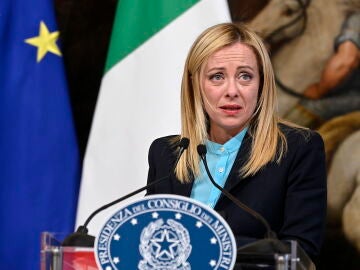
Not even a week has passed since the President of the Spanish Government, Pedro Sanchezmet in Rome with the Italian Prime Minister, Giorgia Meloniin a meeting in which both, from ideological distances, showed their harmony when it came to requiring European solutions to the migration project.
And in seven days, the leader of the far-right Brothers of Italy has chosen to declare the state of emergency in their country of migratory nature for six months, a measure with which they intend to speed up the expulsion of migrants. Because although Meloni became President of the Council of Ministers -official title of his position- on board discontent and promising a strong hand against immigration, the truth is that in recent months the phenomenon has not stopped due to his presence in the Palace Chigi.
In fact, in recent days thousands of people have landed on the Italian coast: more than 3,000 in just three dayswhile the good weather causes more and more boats to cross from Africa to Italy in search of better living conditions.
Not only that, but the Senate is debating a draft Migrant Law to increase the penalties for traffickers and, above all, complicates the work of NGOs that rescue people at sea.
In addition, Meloni’s erratic management of the tragedy in Calabria, where 91 people dieddoes not help: he refused to visit the families, assuring that he did not have time, but he was seen the same night of the Council of Ministers that he held in the area partying at karaoke.
Increase deportations
Now, with an extraordinary measure, the state of national emergency, it is trying to recover part of the credibility lost in this matter by accelerate the expulsion of migrants. Although the approved text is not known in detail, to which five million euros have been allocated, it is known that the structures set up for the repatriation of migrants who do not have the right to remain in Italy will be increased.
The opening of new CPRs (Centro di Permanenza per il Rimpatrio, in Italian) will facilitate identification and deportation activities for the authorities. The Vice President of the Executive, Matteo Salviniwho explained that he saw the need for “at least one repatriation center for each region” and advocated reapplying a harsher policy in the face of the migratory phenomenon.
Salvini, who currently also serves as Minister of Transport, promoted between 2018 and 2019, then as head of the Interior, a severe anti-immigration action with some proceedings that are now being resolved in court, such as its refusal to grant humanitarian ships landing in ports.
After a few particularly intense weeks due to the arrival of thousands of migrants in southern Italy, where less than two months ago a barge capsized in the Calabria region that left more than 90 dead, Salvini assured that Italy is “absolutely incapable” of managing “thousand daily arrivals” and that “It is crucial that Europe wake up and intervene“.
“He has been chatting for years, but he has never lifted a finger, and it is time to show that there is a community, a Union, and that solidarity is not only the responsibility of Italy, Spain, Greece or Malta. Because a thousand arrivals a day we are absolutely incapable to support them economically, culturally and socially,” he said.
With the state of emergency it will also be possible to implement faster procedures and actions to offer migrants reception solutions in a short time and with adequate standards, they stated from the Government, since both Civil Protection and the Italian Red Cross will collaborate in assistance.
The measure, which “allows for the repeal of some rules of the current system”, “will be national” because “we need to help the regions because there is a risk of sending the system to collapse if this rate of arrivals continues,” he added, although he insisted on the importance that Europe “realizes that there isn’t much time”.
Since the beginning of 2023, arrivals in Italy have amounted to 31,000 migrants, almost four times more than the close to 8,000 who did so in the same period of 2022, according to the official count. In the last three days alone, more than 3,000 migrants have arrived in Italy after being treated by the coast guard, which has rescued dozens of boats in distress in the Central Mediterranean this weekend.
The good weather has encouraged a greater number of boats, most of them from Tunisia, to embark on the route that connects North Africa with the coasts of Sicily and Lampedusa, whose reception centers are overflowing.
This Monday, in two complex and long operations, the Coast Guard also intercepted two boats in which 800 and 400 people were traveling in precarious conditions, located in waters close to Sicily and Calabria (south), whose rescue has not yet been completed since They have run out of fuel and a large number of passengers require medical assistance.
Source: Lasexta
Ricardo is a renowned author and journalist, known for his exceptional writing on top-news stories. He currently works as a writer at the 247 News Agency, where he is known for his ability to deliver breaking news and insightful analysis on the most pressing issues of the day.











